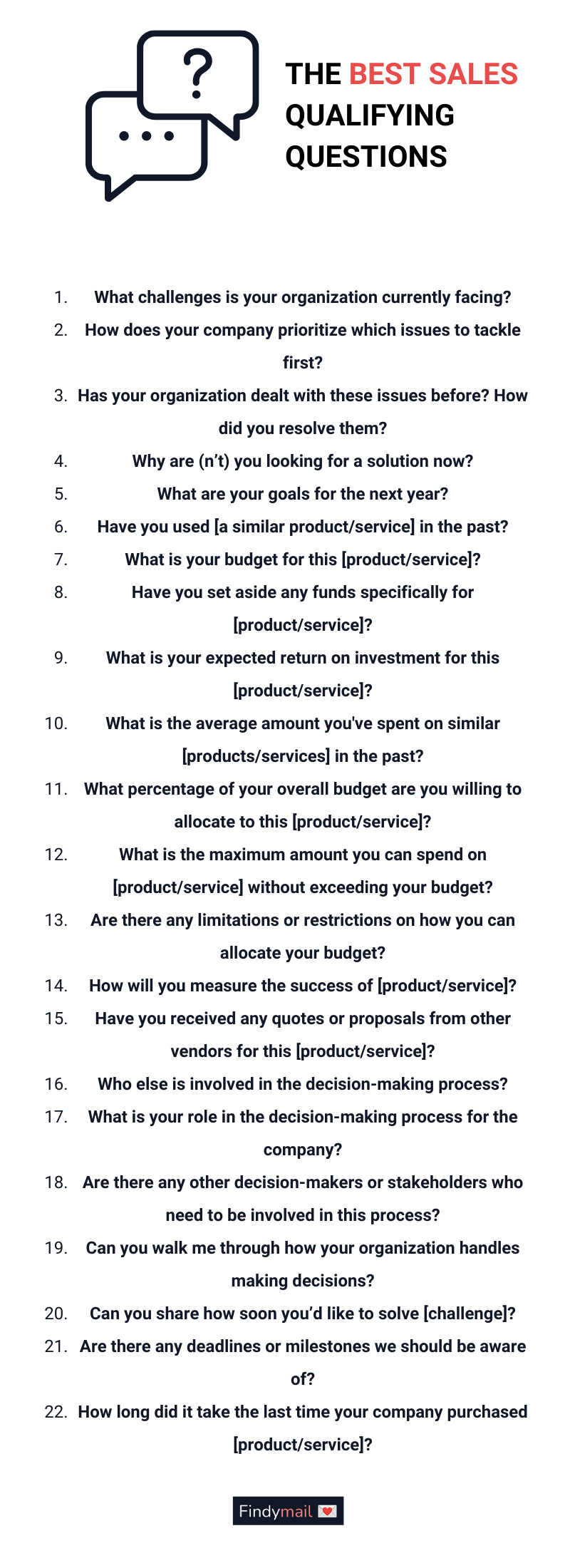Welcome back, my fellow sales warriors!
Let's be frank– getting leads is hard, but closing them is even harder. If we look at the stats, most research puts the lead-to-sale rate at roughly 10% to 15%.
As salespeople, we know that time is our most valuable resource, and every minute spent on a lead that's not going to convert is a minute wasted.
That's why qualifying your leads is crucial. By asking the right questions, you can quickly determine whether a lead is a good fit for your product or service and move on to the next one if they're not. But with so many questions to ask, where do you start?
In this article, I'm going to share with you the 35 best sales qualifying questions that I've found to be the most effective in helping me close more deals in less time.
So grab a snack and let’s dive right into it.
What Is a Sales Qualifying Question?
If you've been in sales for any amount of time, you've likely heard the term "qualifying question" thrown around.
But what exactly is a qualifying question? In short, a qualifying question is a strategic inquiry designed to help you determine whether a lead is a good fit for your product or service.
Keep in mind that you only have a limited amount of time and resources to devote to any one lead. So, you have to use that time wisely.
When you ask the right qualifying questions over the phone or email, you can quickly assess whether a lead has the budget, need, authority, and timeline to purchase your product or service.
If the answer to any of those questions is "no," then you can move on to the next lead without wasting any more of your time.
Using the stats mentioned above, it follows that about 80% or so of your leads won’t be a good fit for your product or service. But that’s okay! The goal is to find ones who will ultimately convert into a sale.
Sales Qualification Methodologies
The great salespeople that came before us have come up with several lead-qualifying methodologies to make our lives easier. These include:
- BANT
- CHAMP
- FAINT
- NEAT
- ANUM
- GPCTBA/C&I
- MEDDIC
Let’s take a closer look at what these acronyms mean.
BANT
First up is BANT– Budget, Authority, Need, and Timeline.
It's the OG of lead qualification methodologies and has been around since the 1960s. BANT is like the classic vintage car of qualifying methods. It's been around for a while, but it's still reliable and gets the job done.
BANT's strength lies in its simplicity - it covers the most critical aspects of lead qualification, making it a good place to start for beginners. Its weakness, however, is that it doesn't go into enough detail on each aspect, leaving room for ambiguity.
CHAMP
Next up is CHAMP– Challenges, Authority, Money, and Prioritization.
CHAMP is like the trendy new car (a Tesla Model 3, maybe?) everyone's talking about. It's modern, sleek, and designed to meet the needs of today's sales world.
CHAMP's strength is that it's a customer-focused methodology. It prioritizes understanding the customer's needs, challenges, and priorities. Its weakness is that it can be time-consuming to implement, as it requires a deep understanding of the customer's business and industry, so it’s best to use a good data enrichment service.
FAINT
Then we have FAINT– Funds, Authority, Interest, Need, and Timing.
FAINT is like the quirky, alternative car that not everyone knows about, but those who do swear by it. Think of the NIO electric cars.
Where FAINT shines is in the fact that it's comprehensive, covering the most important aspects of lead qualification in detail.
However, it can be overwhelming for the customer, as it involves asking a lot of questions, so save it for the leads with the highest priority on your lead list.
NEAT
NEAT– Need, Economic Impact, Authority, and Timeline– is a newer kid on the block, but it's gaining popularity fast. This is the up-and-coming sports car that everyone's eyeing, like the Tesla Roadster.
NEAT emphasizes the economic impact of the customer's needs, making it an effective tool for selling higher-priced products or services. But, unlike other methodologies, it covers the budget in less detail.
ANUM
ANUM– Authority, Need, Urgency, and Money– is a no-nonsense approach to lead qualification. It's a reliable family car that gets you where you need to go without any fuss, like a Kia Sentra.
ANUM is straightforward, making it easy to implement. But it doesn't cover all the necessary aspects of lead qualification, such as the timeline.
GPCTBA/C&I
GPCTBA/C&I or Goals, Plans, Challenges, Timeline, Budget, Authority, and Negative Consequences & Positive Implications. Yes, it’s a mouthful, but it's effective. It’s like the fancy, high-end Lamborghini that only a select few can afford.
It covers all the critical aspects of lead qualification in detail, making it a comprehensive tool for sales teams with sharp sales plans, but it requires a bit of time to get through all the leads asking so many questions.
MEDDIC
Finally, there's MEDDIC– Metrics, Economic Buyer, Decision Criteria, Decision Process, Identify Pain, and Champion. MEDDIC is the Ferrari that's all about the details and the overall experience.
MEDDIC is effective for complex sales cycles because it focuses on the customer's buying process. However, you’ll need a deep understanding of the client’s organization for it to be worthwhile.
I may have overdone it with the car analogy, but it gets the picture through.
The methodology you choose will depend on your personal preference and the needs of your sales team.
Of course, you can take pieces of the ones you like to develop a custom solution for your business.
The 35 Best Sales Qualifying Questions to Ask
Now let’s get into the questions themselves! I will break this section by qualification goals.

Sales Qualifying Questions to Determine if They Are a Good Fit
First, we want to determine if our product/service is even something they can use. You can ask the following questions to get this out the way upfront (but don’t forget to build rapport first):
- Can you tell me more about your company and what you do?
- What challenges is your organization currently facing?
- How does your company prioritize which ones to tackle first?
- Has your organization dealt with these issues before? How did you resolve them?
- Why aren’t you looking for a solution now?
- Why are you searching for a solution now?
- Could [product/service] help you overcome your current challenges?
- What are your goals for the next year?
- Have you used [a similar product/service] in the past?
- Are you looking for [product/service]?
- How did you hear about us?
- What features are you looking for in [product/service]?
Do They Have the Budget?
After figuring out if they’d be a good fit for your product/service, it’s time to find out if they can afford it.
- What is your budget for this [product/service]?
- Have you set aside any funds specifically for [product/service]?
- What is your expected return on investment for this [product/service]?
- What is the average amount you've spent on similar [products/services] in the past?
- What percentage of your overall budget are you willing to allocate to this [product/service]?
- What is the maximum amount you can spend on [product/service] without exceeding your budget?
- What other expenses will be associated with [product/service] that we should be aware of?
- What is your preferred payment schedule?
- Are there any limitations or restrictions on how you can allocate your budget?
- How will you measure the success of [product/service]?
- Have you received any quotes or proposals from other vendors for this [product/service]?
- What factors are most important to you in selecting a vendor for this [product/service]?
Are They the Decision-Maker?
We also want to find out if the person we’re talking to has the authority to pull the trigger so we can close the deal.
- Who else is involved in the decision-making process?
- What is your role in the decision-making process for the company?
- Who will ultimately be responsible for signing off on this purchase?
- Are there any other decision-makers or stakeholders who need to be involved in this process?
- Can you walk me through how your organization handles making decisions?
What Does the Timeline Look Like?
Finally, we need to ask high-value questions to figure out how close we are to a sale to categorize which leads should be a priority.
- Does your company urgently need [Product/Service]?
- Can you share how soon you’d like to solve [challenge]?
- Are there any deadlines or milestones we should be aware of?
- How long did it take the last time your company purchased [product/service]?
- When do you expect you’ll have the budget for [product/service]?
- When are you ready to purchase [product/service] and start using our solution?
Wrapping Up
There you have it– my top 35 sales qualifying questions that will help you close more deals in less time. Remember, asking the right questions is the key to qualifying leads effectively and efficiently so your sales pipeline is as efficient as possible.
It's not about bombarding your prospects with a barrage of questions but instead asking the right ones that help you identify whether they're a good fit for your product or service.
So go forth and ask those questions! (Or try them out for size as part of your sales role-plays.)
And remember to have a little fun along the way!






